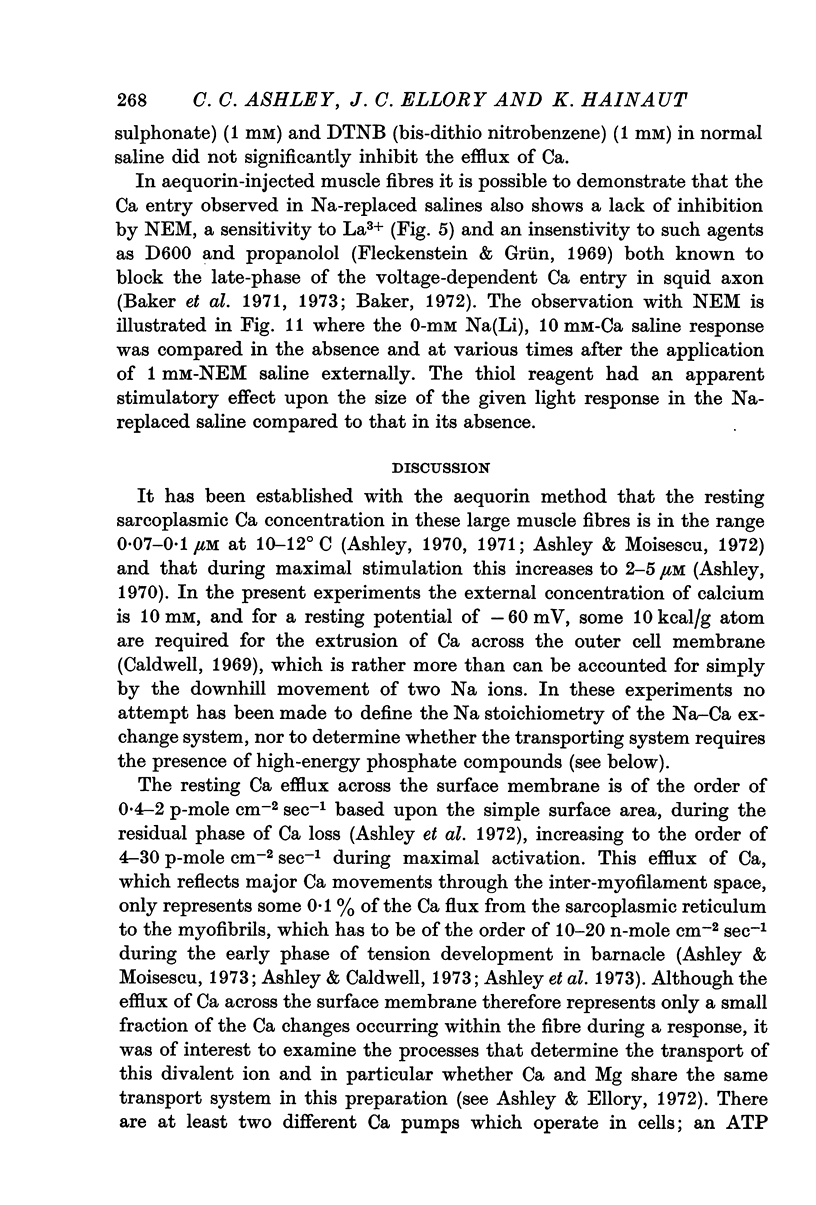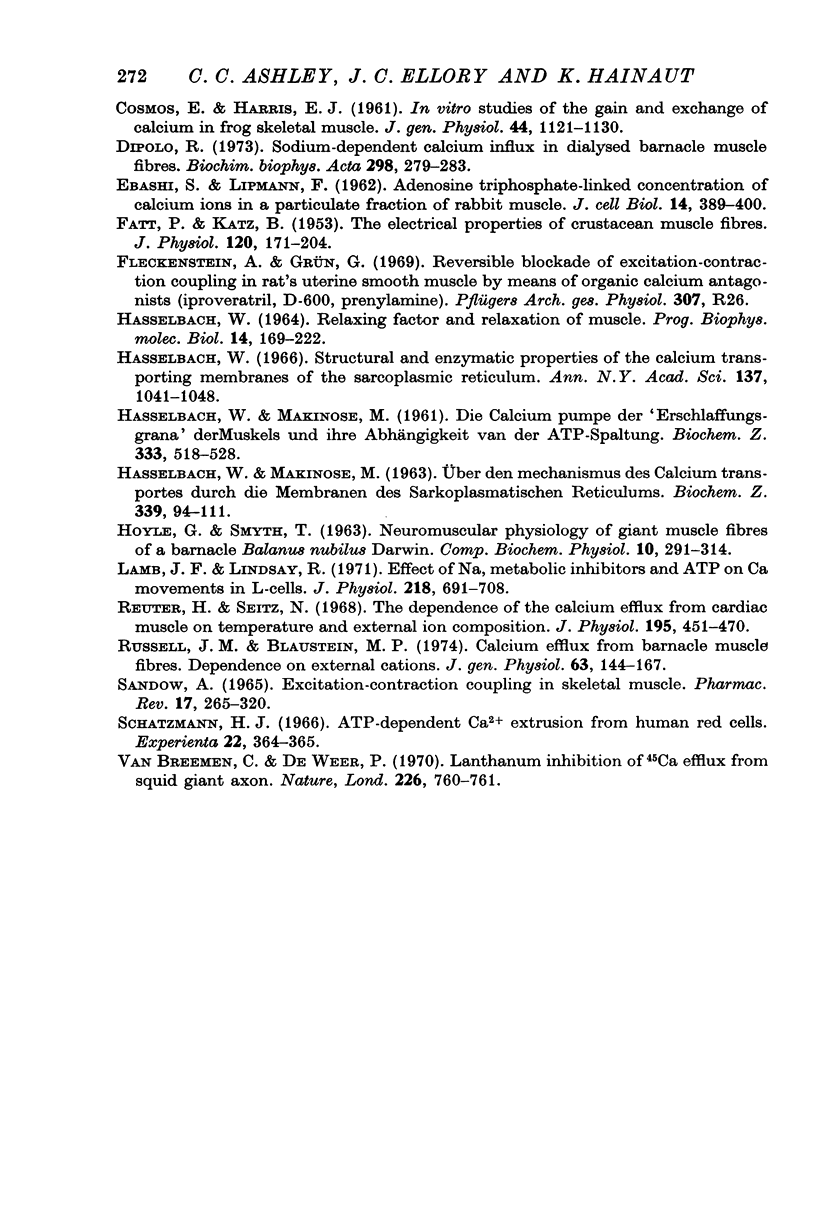Abstract
1. Internal microinjection of the Ca-sensitive photoprotein aequorin or the isotope 45Ca have been used to assess Ca movements in single muscle fibres from the barnacle Balanus nubilus and the crab Maia squinado.
2. Progressive isosomotic replacement of external Na by Li, choline, sucrose or Tris was associated with a rapid increase in the level of light emission from internally injected aequorin. This response was dependent upon the presence of external Ca. The light output was maximal for Na concentrations < 50 mM in the replaced salines, while Na concentrations > 350 mM produced no apparent increase in the resting light emission.
3. If the Ca concentration in the external saline was altered, no effect was observed in Na replaced salines when the Ca concentration was < 1 mM, but maximal effects were observed at concentrations of Ca of ca. 100 mM.
4. The increased light emission from aequorin in Na-replaced salines was substantially inhibited by 1 mM-La3+ applied externally, but not by N-ethyl maleimide (NEM), propanolol or D-600.
5. Following microinjection of 45Ca and 2 hr equilibration, the residual efflux of Ca was shown to be sensitive to the removal of external Ca and Na, the extent of each component being variable.
6. The Na-sensitive Ca efflux was partially inhibited by external La3+ (1 mM), but not by high concentrations of Mg2+, Ca2+, Mn2+ or Co2+. It was stimulated by NEM and ethacrynic acid, which was considered to be due to an indirect effect upon the sarcoplasmic reticulum.
7. It is concluded that Ca movements in these single crustacean muscle fibres involve Na gradients and a Ca: Ca exchange and from the relative insensitivity of Ca movements to various inhibitors, in contrast to the Mg system, it seems that there may be two independent modes for divalent cation transport in this preparation.
Full text
PDF

















Selected References
These references are in PubMed. This may not be the complete list of references from this article.
- Ashley C. C. An estimate of calcium concentration changes during the contraction of single muscle fibres. J Physiol. 1970 Sep;210(2):133P–134P. [PubMed] [Google Scholar]
- Ashley C. C. Calcium and the activation of skeletal muscle. Endeavour. 1971 Jan;30(109):18–25. [PubMed] [Google Scholar]
- Ashley C. C., Caldwell P. C. Calcium movements in relation to contraction. Biochem Soc Symp. 1974;(39):29–50. [PubMed] [Google Scholar]
- Ashley C. C., Caldwell P. C., Lowe A. G. The efflux of calcium from single crab and barnacle muscle fibres. J Physiol. 1972 Jun;223(3):735–755. doi: 10.1113/jphysiol.1972.sp009872. [DOI] [PMC free article] [PubMed] [Google Scholar]
- Ashley C. C., Ellory J. C. The efflux of magnesium from single crustacean muscle fibres. J Physiol. 1972 Nov;226(3):653–674. doi: 10.1113/jphysiol.1972.sp010002. [DOI] [PMC free article] [PubMed] [Google Scholar]
- Ashley C. C., Moisescu D. G. Model for the action of calcium in muscle. Nat New Biol. 1972 Jun 14;237(76):208–211. doi: 10.1038/newbio237208a0. [DOI] [PubMed] [Google Scholar]
- Ashley C. C., Moisescu D. G. The mechanism of the free calcium change in single muscle fibres during contraction. J Physiol. 1973 May;231(1):23P–25P. [PubMed] [Google Scholar]
- Ashley C. C., Ridgway E. B. On the relationships between membrane potential, calcium transient and tension in single barnacle muscle fibres. J Physiol. 1970 Jul;209(1):105–130. doi: 10.1113/jphysiol.1970.sp009158. [DOI] [PMC free article] [PubMed] [Google Scholar]
- Ashley C. C. The role of cell calcium in the contraction of single cannulated muscle fibers. Am Zool. 1967 Aug;7(3):647–659. doi: 10.1093/icb/7.3.647. [DOI] [PubMed] [Google Scholar]
- Baker P. F., Blaustein M. P., Hodgkin A. L., Steinhardt R. A. The influence of calcium on sodium efflux in squid axons. J Physiol. 1969 Feb;200(2):431–458. doi: 10.1113/jphysiol.1969.sp008702. [DOI] [PMC free article] [PubMed] [Google Scholar]
- Baker P. F., Crawford A. C. Mobility and transport of magnesium in squid giant axons. J Physiol. 1972 Dec;227(3):855–874. doi: 10.1113/jphysiol.1972.sp010062. [DOI] [PMC free article] [PubMed] [Google Scholar]
- Baker P. F., Hodgkin A. L., Ridgway E. B. Depolarization and calcium entry in squid giant axons. J Physiol. 1971 Nov;218(3):709–755. doi: 10.1113/jphysiol.1971.sp009641. [DOI] [PMC free article] [PubMed] [Google Scholar]
- Baker P. F., Meves H., Ridgway E. B. Calcium entry in response to maintained depolarization of squid axons. J Physiol. 1973 Jun;231(3):527–548. doi: 10.1113/jphysiol.1973.sp010247. [DOI] [PMC free article] [PubMed] [Google Scholar]
- Baker P. F. Transport and metabolism of calcium ions in nerve. Prog Biophys Mol Biol. 1972;24:177–223. doi: 10.1016/0079-6107(72)90007-7. [DOI] [PubMed] [Google Scholar]
- Blaustein M. P., Hodgkin A. L. The effect of cyanide on the efflux of calcium from squid axons. J Physiol. 1969 Feb;200(2):497–527. doi: 10.1113/jphysiol.1969.sp008704. [DOI] [PMC free article] [PubMed] [Google Scholar]
- Blaustein M. P., Wiesmann W. P. Effect of sodium ions on calcium movements in isolated synaptic terminals. Proc Natl Acad Sci U S A. 1970 Jul;66(3):664–671. doi: 10.1073/pnas.66.3.664. [DOI] [PMC free article] [PubMed] [Google Scholar]
- CALDWELL P. C. CALCIUM AND THE CONTRACTION OF MAIA MUSCLE FIBRES. Proc R Soc Lond B Biol Sci. 1964 Oct 27;160:512–516. doi: 10.1098/rspb.1964.0066. [DOI] [PubMed] [Google Scholar]
- CALDWELL P. C., WALSTER G. STUDIES ON THE MICRO-INJECTION OF VARIOUS SUBSTANCES INTO CRAB MUSCLE FIBRES. J Physiol. 1963 Nov;169:353–372. doi: 10.1113/jphysiol.1963.sp007261. [DOI] [PMC free article] [PubMed] [Google Scholar]
- COSMOS E., HARRIS E. J. In vitro studies of the gain and exchange of calcium in frog skeletal muscle. J Gen Physiol. 1961 Jul;44:1121–1130. doi: 10.1085/jgp.44.6.1121. [DOI] [PMC free article] [PubMed] [Google Scholar]
- Dipolo R. Sodium-dependent calcium influx in dialyzed barnacle muscle fibers. Biochim Biophys Acta. 1973 Mar 16;298(2):279–283. doi: 10.1016/0005-2736(73)90357-x. [DOI] [PubMed] [Google Scholar]
- FATT P., KATZ B. The electrical properties of crustacean muscle fibres. J Physiol. 1953 Apr 28;120(1-2):171–204. doi: 10.1113/jphysiol.1953.sp004884. [DOI] [PMC free article] [PubMed] [Google Scholar]
- HASSELBACH W., MAKINOSE M. UBER DEN MECHANISMUS DES CALCIUMTRANSPORTES DURCH DIE MEMBRANEN DES SARKOPLASMATISCHEN RETICULUMS. Biochem Z. 1963 Oct 14;339:94–111. [PubMed] [Google Scholar]
- HASSELBACH W., MAKINOSE M. [The calcium pump of the "relaxing granules" of muscle and its dependence on ATP-splitting]. Biochem Z. 1961;333:518–528. [PubMed] [Google Scholar]
- HOYLE G., SMYTH T., Jr NEUROMUSCULAR PHYSIOLOGY OF GIANT MUSCLE FIBERS OF A BARNACLE, BALANUS NUBILUS DARWIN. Comp Biochem Physiol. 1963 Dec;10:291–314. doi: 10.1016/0010-406x(63)90229-9. [DOI] [PubMed] [Google Scholar]
- Hasselbach W. Structural and enzymatic properties of the calcium transporting membranes of the sarcoplasmic reticulum. Ann N Y Acad Sci. 1966 Jul 14;137(2):1041–1048. doi: 10.1111/j.1749-6632.1966.tb50216.x. [DOI] [PubMed] [Google Scholar]
- Lamb J. F., Lindsay R. Effect of Na, metabolic inhibitors and ATP on Ca movements in L cells. J Physiol. 1971 Nov;218(3):691–708. doi: 10.1113/jphysiol.1971.sp009640. [DOI] [PMC free article] [PubMed] [Google Scholar]
- Reuter H., Seitz N. The dependence of calcium efflux from cardiac muscle on temperature and external ion composition. J Physiol. 1968 Mar;195(2):451–470. doi: 10.1113/jphysiol.1968.sp008467. [DOI] [PMC free article] [PubMed] [Google Scholar]
- Russell J. M., Blaustein M. P. Calcium efflux from barnacle muscle fibers. Dependence on external cations. J Gen Physiol. 1974 Feb;63(2):144–167. doi: 10.1085/jgp.63.2.144. [DOI] [PMC free article] [PubMed] [Google Scholar]
- Sandow A. Excitation-contraction coupling in skeletal muscle. Pharmacol Rev. 1965 Sep;17(3):265–320. [PubMed] [Google Scholar]
- Schatzmann H. J. ATP-dependent Ca++-extrusion from human red cells. Experientia. 1966 Jun 15;22(6):364–365. doi: 10.1007/BF01901136. [DOI] [PubMed] [Google Scholar]
- van Breemen C., De Weer P. Lanthanum inhibition of 45Ca efflux from the squid giant axon. Nature. 1970 May 23;226(5247):760–761. doi: 10.1038/226760a0. [DOI] [PubMed] [Google Scholar]


